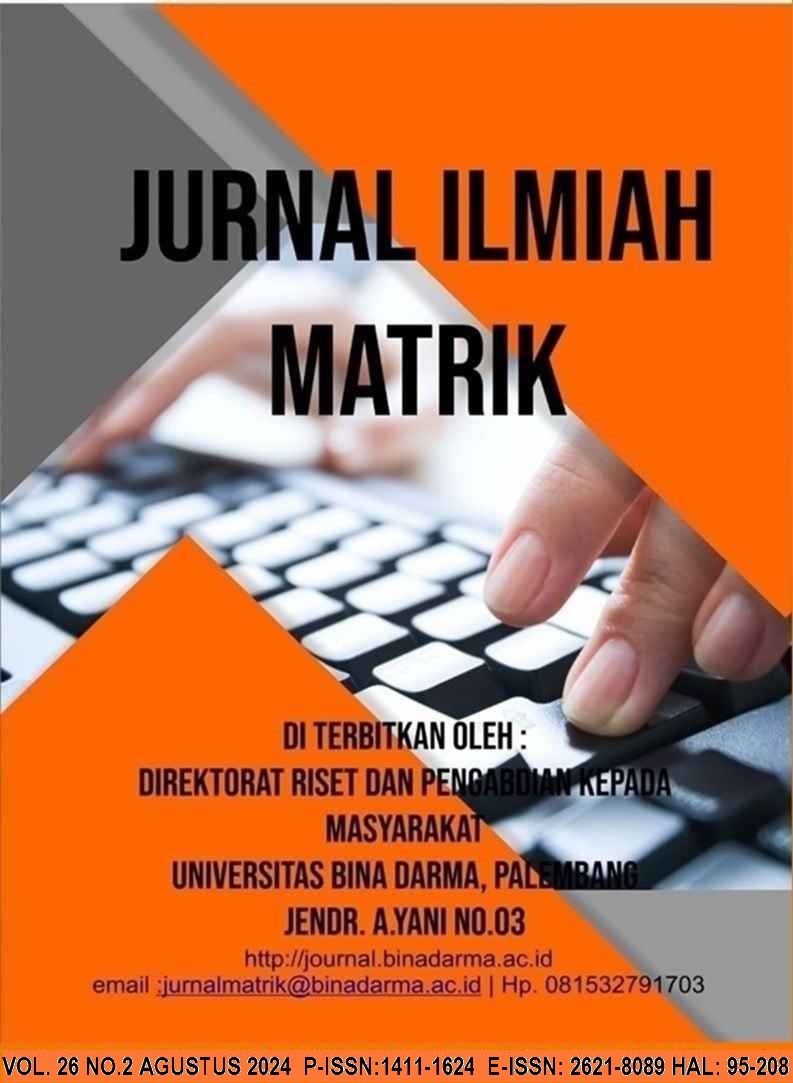Analisis Penilaian Pelayanan Puskesmas Terhadap Pemberian Vaksin COVID-19 dengan Metode K-Means Clustering
DOI:
https://doi.org/10.33557/jurnalmatrik.v26i2.3218Keywords:
K-Means Clustering, Puskesmas, Covid-19Abstract
The Public Health Center is responsible for implementing health policies to achieve health development goals in its area, supporting the realization of a healthy sub-district. One example is the Negeri Lama Public Health Center in Bilah Hilir Sub-district, Labuhanbatu Regency, which serves eight villages with a total population of 36,370 in 2021. The quality of services provided influences patient perceptions, making it essential to continuously improve service quality. This study categorizes the assessment of COVID-19 vaccination services at Negeri Lama Public Health Center using the K-Means Clustering method. This method classifies data into three categories: Very Good Service, Good Service, and Poor Service. The study results show that the Very Good Service category includes six variables with a centroid of 0.519667, the Good Service category includes two variables with a centroid of 0.4605, and the Poor Service category includes two variables with a centroid of 0.3795. This method is considered effective in managing large data accurately
Downloads
References
Kementerian Kesehatan RI, Pedoman Umum Program Indonesia Sehat dengan Pendekatan Keluarga. Jakarta: Kementerian Kesehatan RI, 2016.
A. Agustiansyah, A. R. Mus, and Mahfudnurnajamuddin, “Pengaruh Kualitas Layanan Terhadap Kepuasan Pasien Rawat Jalan Tingkat Lanjutan Di Rumah Sakit Umum St. Madyang Kota Palopo,” Jurnal Magister Manajemen Universitas Muslim Indonesia, vol. 8, no. 1, pp. 36–65, 2021, [Online]. Available: http://pasca-umi.ac.id/index.php/tata
Kementerian Kesehatan RI, “Situasi Terkini Perkembangan Covid-19.” Accessed: Nov. 01, 2022. [Online]. Available: kemenkes.go,id
Kementerian Kesehatan RI, Profil Kesehatan Indonesia Tahun 2018. Jakarta, 2019.
L. T. Ramadhayanti, R. Buaton, and Y. Maulita, “Penerapan Data Mining Pengelompokkan Data Vaksinasi Covid-19 Menggunakan Metode Clustering,” BIMASATI (Bulletin of Multi-Disciplinary Science and Applied Technology), vol. 1, no. 3, pp. 111–114, 2022.
B. Santosa, Data Mining Teknik Pemanfaatan Data Untuk Keperluan Bisnis. Yogyakarta: Graha Ilmu, 2017.
A. Sani, “Penerapan Metode K-Means Clustering Pada Perusahaan,” Jurnal Ilmiah Teknologi Informasi, pp. 1–7, 2018.
A. Bastian, H. Sujadi, and G. Febrianto, “Penerapan Algoritma K-Means Clustering Analysis Pada Penyakit Menular Manusia (Studi Kasus Kabupaten Majalengka),” Jurnal Sistem Informasi (Journal of Information System), vol. 14, no. 1, pp. 26–32, 2018.
I. A. Thaher, A. Septiarini, and N. Puspitasari, “Pengelompokan Kualitas Kinerja Pegawai Menggunakan Metode K-Means Clustering,” Komputika : Jurnal Sistem Komputer, vol. 11, no. 2, pp. 131–141, Jul. 2022, doi: 10.34010/komputika.v11i2.5518.
D. Sartika and J. Jumadi, “Clustering Penilaian Kinerja Dosen Menggunakan Algoritma K-Means (Studi Kasus: Universitas Dehasen Bengkulu),” in Seminar Nasional Teknologi Komputer & Sains (SAINTEKS) , 2019, pp. 703–709. [Online]. Available: https://seminar-id.com/semnas-sainteks2019.html
Downloads
Published
Issue
Section
License
Jurnal Ilmiah Matrik byhttps://journal.binadarma.ac.id/index.php/jurnalmatrik is licensed under a Creative Commons Attribution-ShareAlike 4.0 International License.












